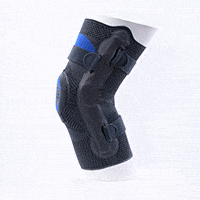Knee pain & instability: a guide to recovery and regaining confidence
- Thuasne Pacific Pty Ltd

- Jul 23
- 3 min read
Updated: Jul 29

A sudden twist during a game of footy, a misstep on an uneven path, or that nagging feeling that your knee might just "give way" without warning. Knee pain and instability are incredibly common issues in Australia, affecting everyone from weekend warriors to busy parents. But understanding what's happening in your knee is the first step towards a confident recovery.
In Australia, it's estimated that knee injuries account for around 8% of all hospitalised sports injuries, making it a significant concern for active individuals. If you're dealing with the aftermath of an injury or a persistent feeling of weakness, you're not alone.
Understanding knee ligament injuries
Most knee injuries involve a sprain or tear of the ligaments, the strong bands that hold the joint together. This is especially common in popular Australian sports like netball, basketball, and AFL, which all involve sudden stops and changes in direction.
The immediate result is often pain, swelling, and a joint that feels tender and weak. But what happens after the initial phase is just as important.
The "Giving way" sensation: what is knee instability?
One of the most common complaints following a ligament injury is a feeling of functional instability, that dreaded sensation that your knee might buckle or "give way" when you walk, run, or even just stand.
This often happens because a previous injury has led to some muscular weakness or because the ligaments themselves have become slightly looser (laxity). This condition can limit your participation in activities you love and create a persistent fear of re-injury, affecting your confidence and quality of life.
The path to recovery: why an active approach is key?
For many knee ligament injuries and the instability that follows, a non-surgical, conservative management approach is the recommended pathway. The goal is to restore function and confidence. This relies on:
Protecting the joint: in the acute phase, managing inflammation is key.
Restoring stability: using external support, like a functional brace, helps prevent re-injury and provides the confidence needed to start moving again.
Encouraging mobilisation: the most crucial part! Gradually reintroducing controlled movement through targeted physiotherapy helps to regain strength, improve balance (proprioception), and restore the body's natural control of the joint.
The role of a functional knee brace in your recovery
Staying active is vital, but so is feeling secure. A functional knee brace is designed to support this active recovery. It's not about immobilising your knee, but about giving it the stability it needs to heal while you move.
A good brace provides external support to protect the healing ligaments, helps to manage any residual swelling, and improves your joint awareness (proprioception). Most importantly, it gives you the confidence to overcome the fear of movement and engage fully in your rehabilitation, which is the key to breaking the cycle of re-injury and getting back to your life.
If you are experiencing knee pain or instability, always consult with a healthcare professional, such as a GP or physiotherapist, for a correct diagnosis and a personalised management plan.
Sources:
Orchard, J.W., & Kountouris, A. (2017). The Management of Australian Football League Injuries. Sports Medicine.
NHS (UK) Inform, "Knee pain".
Australian Institute of Health and Welfare (AIHW), "Sports injury hospitalisations in Australia, 2019–20".
Physiopedia, "Collateral Ligament Injuries of the Knee".
Brukner, P., & Khan, K. (2017). Brukner & Khan's Clinical Sports Medicine: Injuries, Volume 1. McGraw-Hill Education (Australia).
Healthdirect Australia, "Instability of the knee", Australian Government Department of Health and Aged Care.
Physio-pedia, "Knee Active Instability".
NHS (UK), "Knee ligament surgery - How it is performed".



Comments